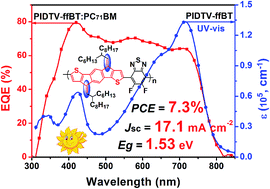A 1,1′-vinylene-fused indacenodithiophene-based low bandgap polymer for efficient polymer solar cells†
Abstract
A 1,1′-vinylene-fused indacenodithiophene (IDTV) donor unit with 22 π-conjugated electrons was synthesized. A ladder-type D–A copolymer PIDTV-ffBT using IDTV as the donor unit and 5,6-difluorobenzothiadiazole (ffBT) as the acceptor unit was developed for application as a donor material in polymer solar cells (PSCs). Compared to other analogue polymers, PIDTV-ffBT possesses a two-dimensional conjugated multi-electron fused ring, excellent planarity and close π–π stacking, leading to a higher light harvesting coefficient, an enhanced charge carrier mobility of 0.032 cm2 V−1 s−1 and improved photovoltaic performance. The PSCs based on PIDTV-ffBT:PC71BM achieved a promising power conversion efficiency (PCE) of 7.3% with a high short-circuit current density (Jsc) of 17.1 mA cm−2. These results indicate that the introduction of the 1,1′-vinylene-fused system into IDTV for ladder-type polymers is an effective strategy to enhance the light absorption coefficient and improve charge carrier mobility for high efficiency PSCs.



 Please wait while we load your content...
Please wait while we load your content...